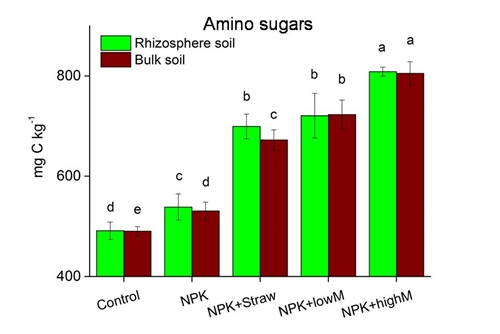Effects of Organic Inputs on Microbial Carbon Use Efficiency and Necromass Accumulation in Paddy Soils Revealed
Soil microorganisms have two contrasting roles in controlling C cycle in terrestrial ecosystems: catabolism and anabolism. Microbial anabolism relative to catabolism, reflected by the carbon use efficiency (CUE), determines the fate of C transformation in soil.
Organic amendments combined with minerals fertilizers can provide both labile C and N sources to microbial communities, the change in microbial CUE under such fertilization treatments is difficult to predict. Understanding how the microbial CUE and microbial necromass respond to fertilization is crucial for the evaluation of the C sequestration potential in intensively managed paddy soils.
The researchers from the Instituted of Subtropical Agriculture (ISA) of the Chinese Academy of Sciences examined the microbial CUE, microbial biomass turnover, and necromass accumulation in rice rhizosphere and bulk soils subjected to long-term (31 years) fertilizations. Five fertilization treatments were included: no fertilizers, mineral fertilizers alone, mineral fertilizers plus rice straw incorporation, and mineral fertilizer combined with a low or a high amount of organic manure.
The team found that rice straw and manure incorporation reduced the microbial CUE in the rhizosphere soil, whereas the CUE remained constant in the bulk soil. CUE was lower in the rhizosphere soil than in the bulk soil due to nutrients uptake and root exudate release by rice plants, leading to a higher C/nutrient ratio in the rhizosphere.
Organic inputs strengthened these rhizosphere processes and could thus weaken the relative potential of C sequestration. The microbial CUE decreased with the increase of the available C/N ratio in the rhizosphere but not in the bulk soil.
The microbial CUE mainly depended on the respiration in the bulk soil and on the microbial growth in the rhizosphere soil, indicating the divergent microbial utilization of organic substrates between rhizosphere and bulk soils.
Organic inputs promoted the microbial biomass growth rate and further increased the amount of microbial necromass by 27–52 % compared with mineral fertilizers alone, which was highly correlated with the soil organic C pools.
This finding suggests that rice straw and manure applications increase C sequestration in paddy soils by enhancing the net flux of microbial biomass formation, and consequently promoting necromass accumulation.
This study, published in Agriculture, Ecosystems and Environment, was supported by the National Key Research Program, National Natural Science Foundation of China, Natural Science Foundation of Guangxi, and Innovation Groups of Natural Science Foundation of Hunan Province.

Fig. 1. Microbial C use efficiency (CUE) in paddy soils under long-term fertilization. (Image by XIA Yinhang)

Fig. 2. Contents of amino sugars in paddy soils under long-term fertilization. (Image by XIA Yinhang)
Contact: Su Yirong
E-mail: yrsu@isa.ac.cn
Institute of Subtropical Agriculture, Chinese Academy of Sciences
Download attachments: